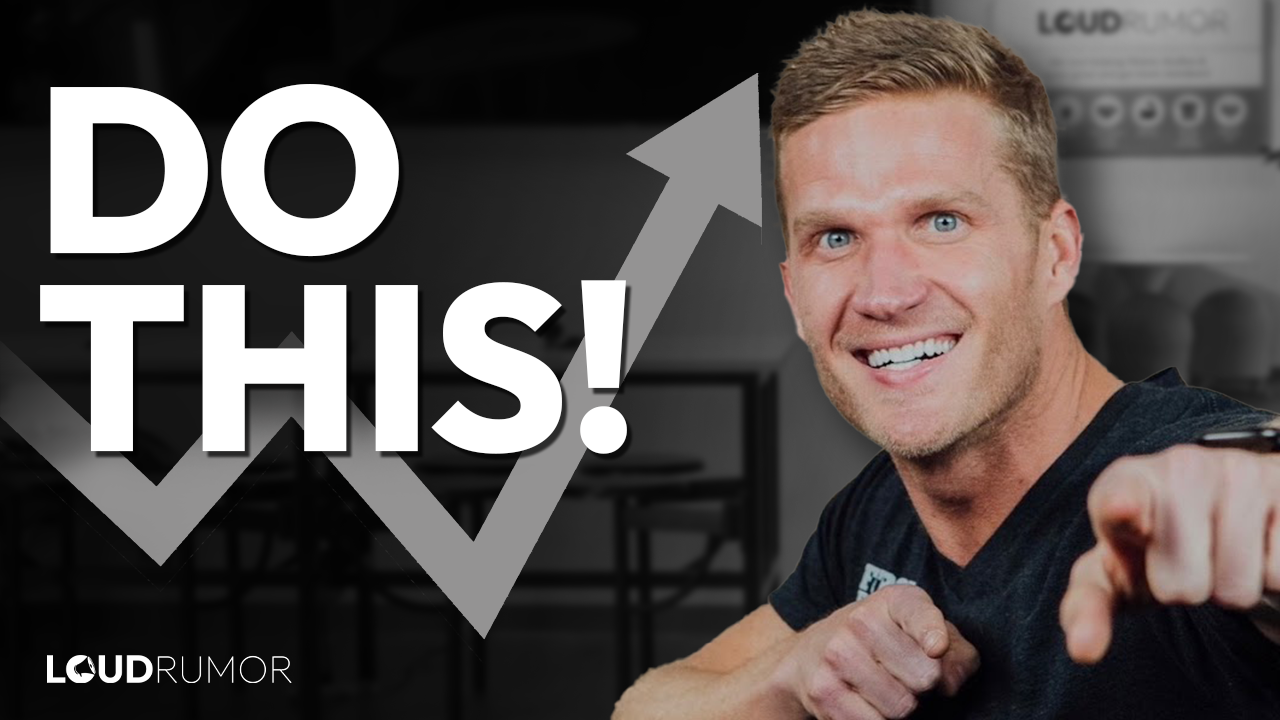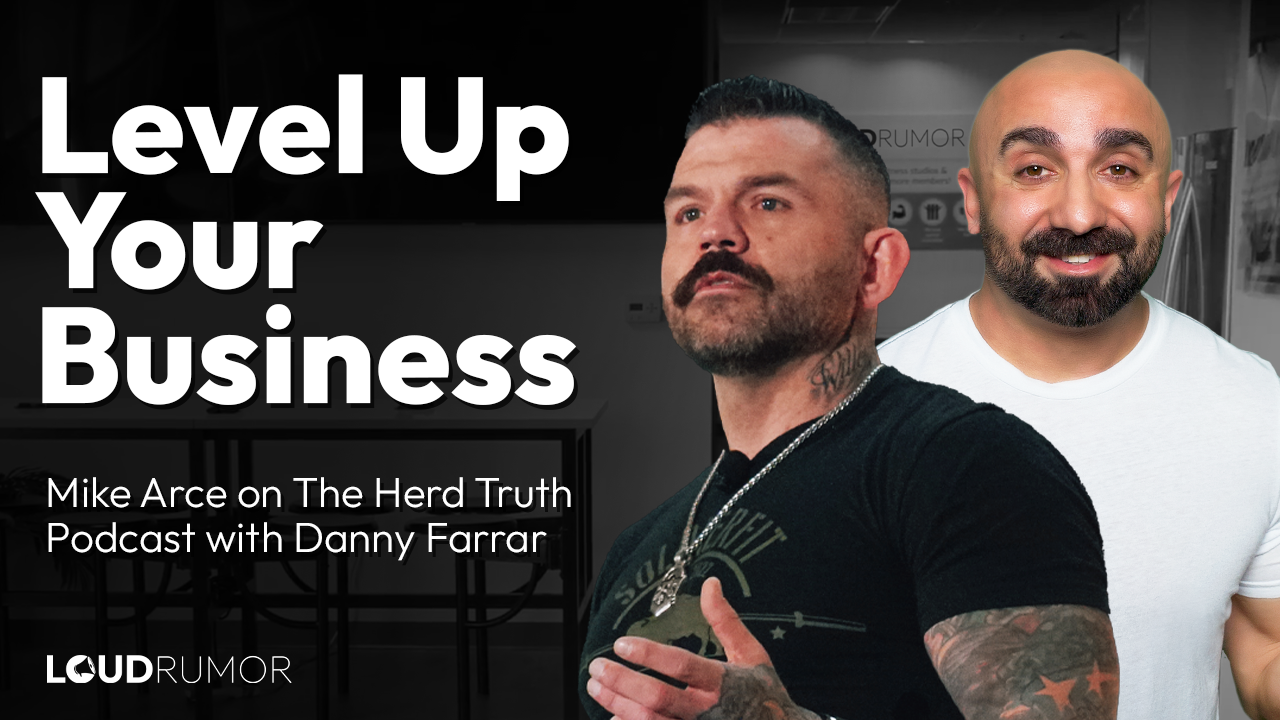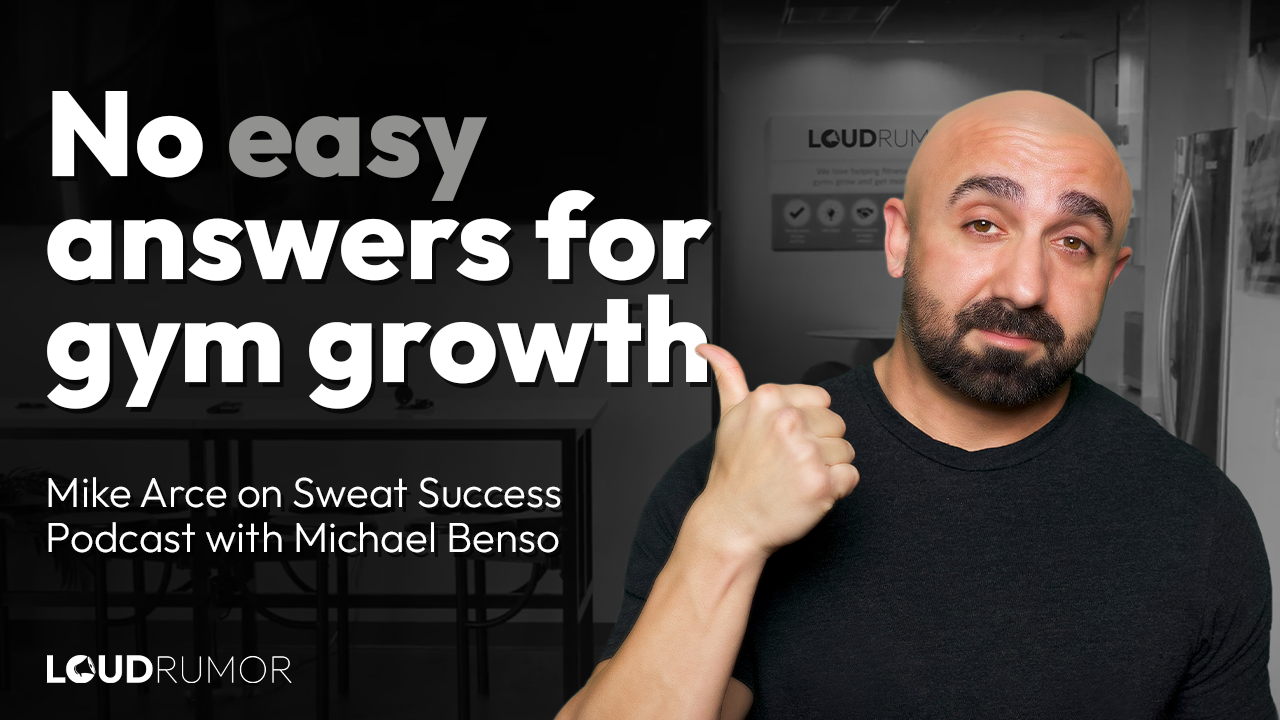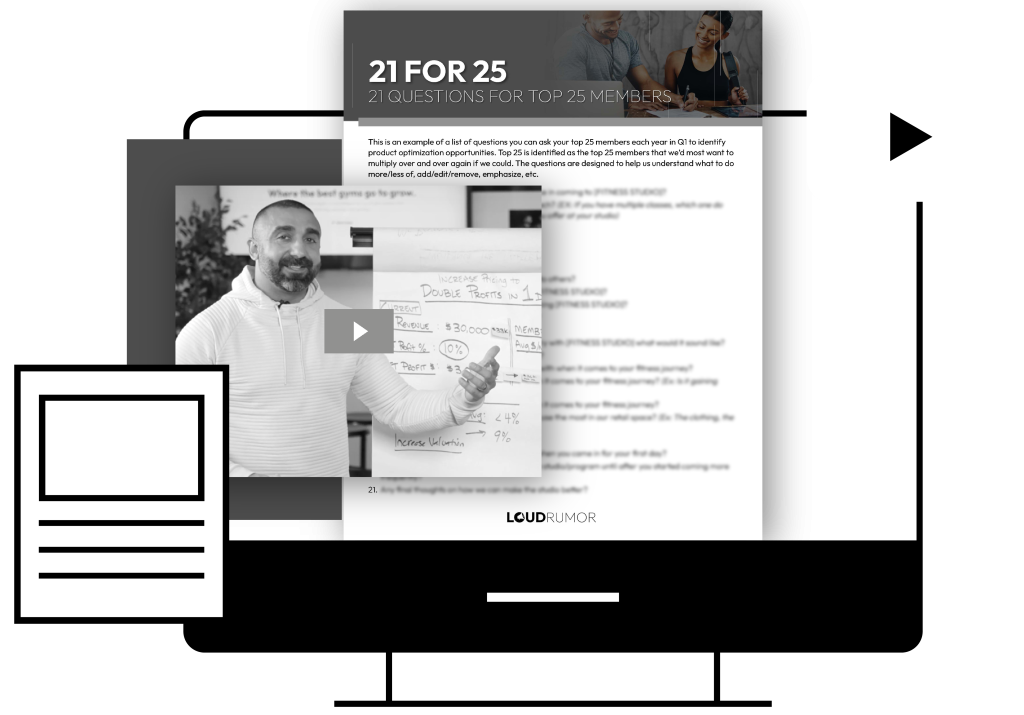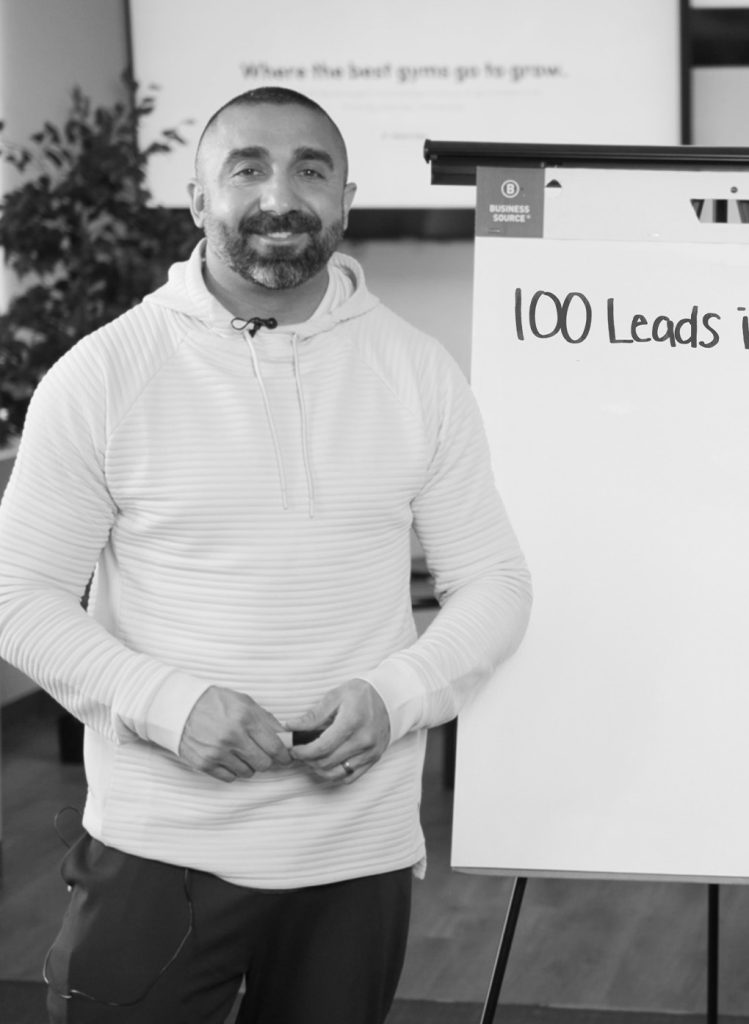In today’s episode, we talk with Matt Kafora on how to see massive gym sales success!
Matt is the owner of seven Orangetheory Fitness Studios, which is considered the leading franchise in the fitness industry. His studios, located across Arizona, generate an average of well over $100K per month and have the number one and number four stores in the franchise. Despite his success, Matt is hands-off and doesn’t have to visit his stores often.
Today he shares with us four things to be dangerously good at in your fitness studios sales process to be successful. One of the many “plays” found in Loud Rumor’s 360+ program.
1. Lead Generation
Let’s talk about the first thing people have to be dangerously good at in order to be extremely successful in the fitness industry. Fitness as a whole is a pretty simple business, but it’s not easy. The first thing that needs to be done is to let people know where we are, who we are, and that we even exist.
Lead generation is truly the first step in the entire sales process, and with lead generation, you’re not just talking about paid ads. When we hear lead generation, we often think of Facebook and Instagram ads, but it’s important to remember that lead generation involves a series of things.
Of course, digital platforms such as Facebook, Instagram, Google, and YouTube are important, but you can’t survive off of just one line in the water. Far too often, we see business owners who want to sink 90% of their lead generation into digital marketing, but what if Facebook or the digital landscape changes? We need multiple lines in the water.
Ground and pound techniques, such as door hangers, flyers, parking lot promotions, B2B networking, and internal plays with existing member bases are just a few of the different ways to generate leads.
The best advice is to deploy all of them, and have multiple lines in the water. If you don’t, you won’t catch anything. We dive into 5 of the lines in this video!
Refer & Receive
Once you have a good flow of leads coming in, if you can get five leads a day coming in on a regular basis from all different avenues, it’s fantastic. Depending on where those leads come from, you may not need so many. If you have a really good referral program, the conversion rates and referrals are a lot better. A hundred referrals are way better than 200 digital leads.
“I absolutely love my existing members – they are the ones who keep my business afloat and allow me to provide for my family and team. That’s why I believe in showing them appreciation and giving back to them through the “refer and receive play”. This strategy involves offering existing members something in return for referring new members to our business.
Matt finds this strategy to be incredibly instrumental in his business, and it’s one of the strongest referral generators we have. He’s seen other businesses, like gyms we work with, get up to 100 warm referral leads in just 24 hours through this strategy. It all starts with just asking our members, but first and foremost, we need to show them love and prioritize their needs. Only then can we expect them to refer others and get something in return.

2. Client Intake Form
Number two on the list of important factors for any fitness business is client intake. Once you have worked hard to get leads and booked them for a workout, the client intake process is where the relationship with your potential clients really starts to take shape.
The purpose of the client intake process is twofold. First, you want to understand the reason why they stepped foot in the gym in the first place. While most people assume that the reason is related to their fitness goals, this is not always the case. In reality, the why behind their goal is far more important, as it is often the emotional hot button that will drive them to achieve their fitness goals.
As a fitness professional, it’s important to dig deep to uncover the true reason why someone has decided to take action and step into your gym. For many people, this decision is driven by pain, whether it be physical, emotional, or mental. Once you understand what is truly motivating your client, you can use this information to create a personalized fitness plan that speaks to their needs and helps them reach their goals.
The second goal of the client intake process is to identify any objections that may arise down the line. By addressing objections early on, you can save time and effort in the future, as well as provide your clients with a sense of reassurance and support.
Booking Leads With a Credit Card
Matt discusses some strategies that his team uses to increase show rates for fitness classes. His team uses a credit card to book appointments and encourage people to bring a friend, which helps to fill classes and increase the chances of making a sale. Matt estimates that his team asks for a credit card 90% of the time and gets pushback occasionally, but they encourage role-playing to build confidence and minimize the importance of the request. This strategy has helped to double show rates and make it easier to sell.
Tips to a Successful Intake
The first step of the intake process is for the individual to fill out the demographic information on the client intake form, including their name, address, email, employer, and emergency contact. This is the only part of the form that the individual fills out themselves. The employer information is important as it can lead to corporate contacts and potential on-site visits, while the emergency contact is crucial for the individual’s safety and becomes a potential referral opportunity. Overall, the intake process aims to create a fun, exciting, and engaging experience that extends a courtesy to the individual rather than the other way around.
Once the clients fill out the demographic information on their own, sit down with them to go through the rest of the client intake questions. By doing so, they can better understand their clients’ goals and the reasons behind them, which is crucial to provide a personalized and quality experience. Matt points out that sitting next to the client, rather than across from them, can create a more intimate and collaborative environment, enhancing the sales process.
Matt highlights the importance of asking open-ended and detective-like questions, such as “why” and “what brought you in today,” to dig deeper and help the client visualize their desired outcome. He shares a story of a client who wanted to lose 40 pounds, but the real reason behind it was to protect her son from being bullied at school. It’s not the goal that matters the most, but the underlying reason and emotional connection behind it, which can be a deciding factor in making the sale.
3. Transfer of Trust and Pricing
The next step in the process is the transfer of trust or a “handoff” between the initial salesperson and the coach or instructor who will continue working with the client. This transfer involves obtaining permission from the client to share their information and fitness goals with the coach, and ensuring a smooth transition between the two professionals.
We have full trainings and certifications on how to master all the steps in the sales process for your gym. Click below to learn more!
The coach or instructor is viewed as a fitness professional and is better equipped to guide the client on their fitness journey. After the coach works with the client, they do a “hand back” to the salesperson, providing feedback on the client’s progress and any prescriptions for their fitness routine. This allows for the gym to control the client’s journey and ensure a positive experience.
Matt compares this process to a doctor giving a prescription and emphasizes the importance of guiding the client along their journey, similar to a buying assistant. Overall, the transfer of trust and handoff process is essential in providing quality service to gym members.
Presenting Pricing
If the previous steps have been done well, the price presentation becomes more of an order taking process, where the customer is shown one option based on the prescription given by the fitness professional. The goal is to overcome objections prior to them becoming objections, so that the only potential objection left is the price. Matt shares the importance of finding a solution that works for the customer and helps them reach their goals, even if it is not the top tier option.
Matt also discusses the emotional aspect of the sales process, and how it is important to tie everything back to the customer’s emotional needs and desires. He points out that people will often spend money on what they want, rather than what they need, so it is important to connect the prescription to the customer’s wants in order to make the sale. The sales process is not just about making a sale, but about changing lives, so it is important to find the right solution for each individual customer.
4. Infinite Return
Amateurs add, professionals multiply. The last step is the referral process and it’s one of the most important steps in the sales process. Referrals provide an infinite return on investment, lowering customer acquisition costs and leading to higher conversion rates than digital leads or cold calls.
A referral comes with the trust of the referrer, which raises the conversion rate, and helps the salesperson, the client or the member making the referral. Therefore, the referral process can help to turn one customer into many, differentiate your business from your competition, and bring explosive growth to your business.
The referral process helps you to ask for five referrals from each customer and can help to change your business from an amateur level to a professional one. You don’t need a massive business acumen to make this happen; you only need to ask for referrals to increase your customer acquisition, and lifetime value and to keep your customer longer.
In our 360+ program, we have step-by-step guides and scripts on how to get point-of-sale referrals. Some of our best members get 5+ referrals at the point of every sale!









